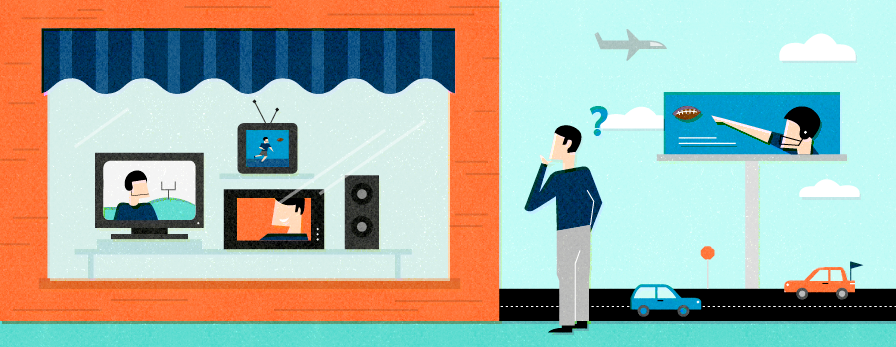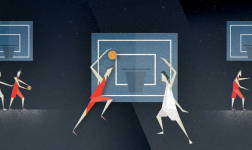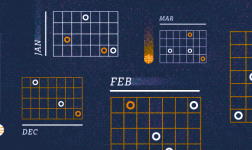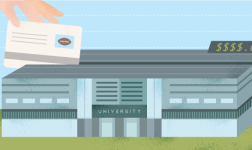While focusing on current issues, it’s also crucial that athletic directors keep an eye toward the future and potential changes on the horizon. In this article we take a look at one possible transformation, a student-athlete licensing program, and its prospective impact on the NCAA and its member institutions.
Read our latest post about the Ed O’Bannon lawsuit and creation and financial consequences of a student-athlete trust fund.
Contributors: John Infante, Mike Corgan, and Peter Baran
This article imagines the legal analysis and practical implications for the possibility of an NCAA student-athlete licensing program. Questions this article considers: How could an NCAA student-athlete licensing program come into existence? (Part I); If it does, what are the Title IX considerations? (Part II); And finally, what are two possible approaches for such a licensing program, framed around subject areas that require consensus for a successful legislative process? (Part III).
We started thinking about this article idea in the context of a larger conversation in the public sphere around fairness, and to what extent the theme of “fundamental fairness” shapes and impacts dialogue that influences policy makers, 1 including athletics administrators; and what might be under-weighting in prospective leadership that has the potential to be paradigm shifting, relative what dominates the debate and media coverage at present for college athletics (e.g., BCS re-cutting and consequences around new television revenues).
With the meta-theme of fairness in mind, we wondered how a climate of fairness could influence outcomes in college athletics. Certainly, President Emmert’s leadership, through the working groups, is addressing the implications of fairness on various subjects (e.g., multiyear scholarships; up to $2,000 expense stipend; compliance reform, et al). Tangential to these internal policy considerations by the NCAA are equally compelling events and debates (e.g., conference realignment), which themselves carry a fairness theme.
The interaction of those NCAA internal and external events with the public writ large can be provocative. Specifically, given the potential interplay between the outcome of In re: NCAA Student-Athlete Name & Likeness Licensing Litigation 2 and previously proposed NCAA legislation (No. 2010-26, pending further comments as of January 13, 2011), in this article we explore a path to the possibility of a student-athlete licensing program becoming a reality.
Part I: The Combined Licensing Litigation & its Background
In 2009, former college basketball standout Ed O’Bannon filed a class-action lawsuit on behalf of himself and other former college athletes against the NCAA and Collegiate Licensing Company (“CLC”), the entity that manages the NCAA’s licensing agreements. The complaint alleged that the NCAA’s failure to compensate former student-athletes for the use of their likenesses in video games, television broadcasts, memorabilia, advertisements, and other promotional ventures violated federal antitrust laws. 3 Citing the Sherman Antitrust Act, 4 O’Bannon asserted that the NCAA and CLC created an unreasonable restraint of trade by conspiring to “fix the price for the use of his image at zero.” 5 This restraint depressed prices paid by the NCAA and CLC for the likenesses of student-athletes and thereby eliminated market competition.
The impetus for the lawsuit is “Form 08-3a”, which the NCAA requires student-athletes to sign before participating in athletics. Via the form, student-athletes give the NCAA permission to use their images and likenesses to “promote NCAA championships or other NCAA events, activities or programs.” 6 O’Bannon asserts that Form 08-3a is an unenforceable “adhesion contract” 7 through which the NCAA compels uninformed college athletes to forfeit all rights to license their images and likenesses. Because of this document, O’Bannon asserted student-athletes are unable to negotiate deals for the use of their likenesses. As a result of the gross inequity in bargaining power between the NCAA and the student-athlete, O’Bannon is essentially arguing that this arrangement is fundamentally unfair.
In a similar class-action lawsuit, former Arizona quarterback Sam Keller sued EA Sports for using his likeness in its video game without providing Keller with proper compensation. The O’Bannon and Keller lawsuits have since been combined into one class-action lawsuit entitled In re: NCAA Student-Athlete Name & Likeness Licensing Litigation, which is currently at the district court level in California. 8 In the combined trial, the NCAA moved to dismiss the lawsuit, but the district court disagreed and permitted the lawsuit to move forward. Consequently, the trial is now in the discovery phase, in which the student-athlete plaintiffs are requesting all documents related to the NCAA’s licensing agreements. 9 These agreements are worth an estimated $4 billion. 10
Looking ahead, if O’Bannon prevails, it may be because the court finds that former college athletes have a market for the commercial use of their likenesses (perhaps evidenced by the amount of money generated from them by the NCAA and other commercial entities) and that preventing former college athletes from negotiating their own deals for the use of their likenesses is a restraint of trade. Although prior courts have considered the preservation of the collegiate amateur model as a worthy justification for the NCAA’s current licensing system, 11 this argument could carry considerably less weight when discussing former athletes who have long since left school. 12 Thus, is it possible that O’Bannon and his co-plaintiffs will prevail?
Although the final outcomes of these cases remain uncertain, court-ordered mandates to compensate former college athletes for the use of their likenesses in video games, memorabilia, and other promotional ventures could drastically change the current landscape of college sports. Because the combined student-athlete lawsuit focuses only on providing payments to former college athletes, a verdict in favor of the plaintiffs would not require the NCAA to compensate current student-athletes. Such a verdict, however, could force the NCAA to establish some form of a trust fund to retroactively compensate former student-athletes whose likenesses have been used by the NCAA or licensed to other entities by CLC. 13 Once current or future college athletes leave school, these athletes would then become eligible to receive financial compensation from the trust. 14 Such a program raises myriad Title IX considerations.
Part II: Title IX Considerations
To analyze the issues relating to Title IX for a student-licensing program, it is helpful to examine this federal statute, and provide some background information. 15 The entity charged with oversight of Title IX enforcement is the Office for Civil Rights (OCR), a branch of the U.S. Department of Education. To assist in the interpretation of Title IX, OCR published several documents to clarify how institutions are to comply with Title IX vis-à-vis college athletics. The most well-known 16 and significant of these is what is commonly known as the Three-Part Test. Technically speaking, the Three-Part Test is not a three-part test at all, but rather three different ways in which an institution can comply with Title IX’s requirements. The three parts (or ways) in which an institution can comply with Title IX in athletics are:
- Whether intercollegiate athletic participation opportunities for male and female students are provided in numbers substantially proportionate to their respective undergraduate enrollment.
- If those numbers are not substantially proportionate, the institution is still in compliance if it can show a history and continuing practice of program expansion for the underrepresented gender.
- If the institution does not have a history and continuing practice of program expansion, it is still in compliance with Title IX if it can show that the interests and abilities of the underrepresented gender have been fully and effectively accommodated by the institution. 17
How institutions choose to comply with Title IX varies from institution to institution. 18 On the NCAA level, the Supreme Court, in NCAA v. Smith, 19 held that Title IX does not apply to the NCAA despite the fact that the NCAA receives dues from federally funded intercollegiate athletic programs that fall under the scope of Title IX. 20 As a result, if the NCAA established a trust fund, or other such licensing program, to disperse compensation to former college athletes, it probably would not violate Title IX because the NCAA would be the entity distributing the funds, not the member institutions.
Even if an NCAA licensing program is able to avoid violating Title IX, countless practical problems remain for institutions to face. Legal sports scholar Michael McCann projects that the NCAA could face potential liabilities of hundreds of millions of dollars because damages are tripled under federal antitrust law, though other legal scholars have disputed this assertion. 21 Regardless of the amount of damages, an NCAA-established compensation program would decrease funds provided to its member institutions, which could ripple into funding levels for salaries, facilities, and so forth.
Part III: Licensing Models
In view of the path to a licensing program and the Title IX considerations, we can broadly imagine two kinds of approaches to developing such a model across six subject areas. We call the first type the “Hands-Off Approach” and the second type the “Hands-On Approach.” In the Hands-Off Approach, the NCAA simply deregulates the bylaws and regulations relative licensing (e.g., the aforementioned Form 08-3a) while protecting academics and competitive equity as much as possible. In the Hands-On Approach, the NCAA actively regulates the student-athlete likeness market, the NCAA and institutions participate in that market, and the NCAA provides additional services to student-athletes and institutions. These approaches are designed to demonstrate two possible ends of the licensing spectrum. This is done intentionally to illuminate the challenges that institutions potentially face should the NCAA adopt any type of licensing model. Our goal in this regard is to frame the issues with a view toward elements to consider in a consensus approach for successful legislation, should events reach that stage.
Agents
Hands-Off Approach
The NCAA would simply remove the portions of Bylaw 12.3 that prevent student-athletes from entering into agreements with agents, receiving benefits from agents, or having agents market their likenesses or athletic reputations to commercial entities. Legal counsel would be permitted in any capacity, with services allowed either pro bono or paid for by an agent. Because schools would not be allowed in the likeness market, athletic scholarship agents would still be prohibited or tightly restricted to prevent shopping of athletes to schools.
Hands-On Approach
The NCAA would certify all agents prior to their being permitted to represent student-athletes. Agents would be permitted to market student-athletes’ marketing rights only, rather than acting as player agents. Agents would be prohibited from providing benefits to student-athletes, including to student-athletes who have already agreed to be represented by the agent.
Commercial Promotions
Hands-Off Approach
Most of Bylaw 12.5 would be eliminated. Student-athletes would be permitted to engage in any type of commercial, non-profit, educational, institutional, or charitable promotion. There would be no cap on the amount of money student-athletes could receive for these promotions, and no restrictions on broader deals for all of a student-athlete’s likeness rights. 22
Hands-On Approach
The NCAA would operate a clearinghouse that would monitor and certify all marketing agreements signed by student-athletes. Most types of commercial and non-commercial promotional activities would still be permitted. Student-athletes would be required to receive payment only for work actually performed, which would prohibit agreements for all of a student-athlete’s marketing rights.
Involvement of Institutions and the NCAA
Hands-Off Approach
Neither the NCAA nor institutions would be permitted to compensate a student-athlete for use of his/her likeness. Student-athletes would have to license their likenesses to the NCAA, conferences, or institutions voluntarily or for free. These organizations would, however, be permitted to use a student-athlete’s likeness in media activities, such as the broadcast and replay of games, and the reporting of results.
Hands-On Approach
Institutional agreements with student-athletes would go through the same process as agreements with companies and other commercial entities, with the NCAA approving all agreements. Review of institutional agreements may include standard rates for certain activities. The NCAA would also pay student-athletes to use their likenesses, but would be permitted to pay student-athletes only for products that include all student-athletes, like video games.
Student-Athlete Assistance
Hands-Off Approach
Neither the NCAA nor institutions would be permitted to provide assistance to student-athletes in marketing their likenesses. Help with agent selection, seeking out marketing deals, and financial advising would all be prohibited. Professional sports counseling panels would also be prohibited.
Hands-On Approach
Institutions and the NCAA would both actively assist student-athletes in selecting an agent. Institutions would also be permitted to assist student-athletes in finding marketing deals as well as providing financial advising or help finding a financial advisor.
Student-Athlete Releases
Hands-Off Approach
Section IV of the NCAA’s Student-Athlete Statement would be amended to become more clearly voluntary, outside of the NCAA’s protected media activities. Institutional releases would also need to be clearly voluntary and would be required to separate necessary releases from unnecessary releases. 23
Hands-On Approach
Section IV of the Student-Athlete Statement would be made voluntary, with the NCAA also informing student-athletes of the standard rates for certain NCAA activities if the student-athlete chooses to grant the NCAA a license to use his/her likeness. Institutional releases would still be separated into necessary access and use of educational records and voluntary use of a student-athlete’s likeness. Like the NCAA, institutions could apply standard rates for certain marketing rights.
Competitive Equity and Academics
Hands-Off Approach
Student-athletes would be prohibited from missing class time for promotional activities. To prevent income from student-athletes marketing their likenesses from overwhelming scholarship limits, hard roster caps would be included as well.
Hands-On Approach
Prohibitions on missing class and hard roster limits would be used to promote competitive equity. In addition, student-athletes would be prohibited from engaging in promotions outside of the offseason and any institutional vacation periods.
Of course, it’s difficult to reach a fairly reasoned and reliable conclusion to any imagined scenario, especially where, as in this situation, there are so many moving parts and unknown factors in college athletics at present (and perhaps as always). Suffice to say that if such a hypothetical evolved into a possibility, there would be dramatic impact on many facets of college athletics (for athletic directors [ADs], how to engage media, donors, recruits, faculty, and current student-athletes in an informed and thoughtful dialogue about the “what got us here”, how that landing spot is shaped, and what it means for their respective interests).
But perhaps that’s a matter of perspective. Maybe what appears like a revolution up close is nothing more than evolution from afar. Maintaining that duality while doing one’s day job is certainly much more than an easy task, especially given the unforgiving media spotlight on athletics administrators. We hope that this article helps ADs consider the best decisions in the context of a bigger picture, including anticipating what may be ahead given the current landscape and the different options, mitigations, and outcomes for alternative decision trees.
What are other leaders doing, and what are some emerging trends? In each issue of The Winthrop Digest, we will share what we are seeing. We are proud to feature submissions from academia and college athletics professionals to promote best practices.
John Infante
We give special thanks to John Infante for this article. John is the NCAA expert for Athnet and creator of The Bylaw Blog at athleticscholarships.net
Mike Corgan
We give special thanks to Mike Corgan. Mike is a third-year law student at Villanova University School of Law. He is also one of the Managing Editors of Outside Articles for the Villanova Sports and Entertainment Law Journal. Mike’s Comment, entitled “Permitting Student-Athletes to Accept Endorsement Deals: A Solution to the Financial Corruption of College Athletics Created by Unethical Sports Agents and the NCAA’s Revenue-Generating Scheme,” was published in the 19th issue of the Villanova Sports and Entertainment Law Journal (19 VILL. SPORTS & ENT. L.J. 371) (discussing legal and practical issues that may arise if student-athletes begin to receive compensation for participating in promotional ventures).
Peter Baran
We give special thanks to Peter Baran, Director of Compliance at Villanova University. He is also a graduate of Marquette University Law School, where he focused on sports law at the National Sports Law Institute.
Key Insights
A ruling for the plaintiffs in the current class-action lawsuit could drastically change the landscape of college sports, forcing the NCAA and its member institutions to compensate former student-athletes for the use of their likenesses in video games, memorabilia, and other promotional materials. Although the implementation of such a licensing program isn’t imminent, athletic directors should anticipate the road ahead to alleviate the possible impact on their universities.
References:
- What is fair – Greek debt and the Euro; health insurance affordability in the U.S.; the one percent as well as tax policy, including carried interest, as topics in the current political primary season. ↩
- http://www.pbs.org/wgbh/pages/frontline/money-and-march-madness/ncaa-lawsuit/#5 ↩
- O’Bannon v. NCAA, 2010 WL 445190 (N.D. Cal. 2009). ↩
- 15 U.S.C.A. §1 (2011): “Every contract, combination in the form of trust or otherwise, or conspiracy, in restraint of trade or commerce among the several States, or with foreign nations, is declared to be illegal.” ↩
- See O’Bannon, 2010 WL 445190, at *2 (quotation omitted). ↩
- See id. , at *1 (quotations omitted). ↩
- A type of contract, a legally binding agreement between two parties to do a certain thing, in which one side has all the bargaining power and uses it to write the contract primarily to his or her advantage. See http://legal-dictionary.thefreedictionary.com/Adhesion+Contract ↩
- http://www.pbs.org/wgbh/pages/frontline/money-and-march-madness/ncaa-lawsuit/#5 ↩
- http://www.nytimes.com/2010/02/09/sports/ncaabasketball/09ncaa.html ↩
- http://www.nytimes.com/2010/02/09/sports/ncaabasketball/09ncaa.html ↩
- See NCAA v. Bd. of Regents, 468 U.S. 85, 102 (1984) (describing differences between college football and professional sports, and asserting distinct nature of college football derives, at least in part, from the prohibition of paying student-athletes) (contending that NCAA’s regulations pertaining to amateurism “plays a vital role in enabling college football to preserve its character, and as a result enables a product to be marketed which might otherwise be unavailable”). ↩
- See William D. Holthaus, Jr., Ed O’Bannon v. NCAA: Do Former College Athletes Have a Case Against the NCAA for Its Use of Their Likenesses?, 55 Saint Louis University Law Journal 369, 393 (2011) (parenthetical). ↩
- PBS, Transcript of Interview with Michael McCann (Jan. 29, 2011), available at http://www.pbs.org/wgbh/pages/frontline/money-and-march-madness/interviews/michael-mccann.html (noting possibility that NCAA could compensate players through trust if O’Bannon wins his lawsuit). ↩
- Michael McCann, NCAA Faces Unspecified Damages, Changes in Latest Anti-Trust Case, SI.com (July 22, 2009, 9:51 AM EST), http://sportsillustrated.cnn.com/2009/writers/michael_mccann/07/21/ncaa/index.html ↩
- Originally passed in 1972, Title IX mandates gender equity in education by ensuring that men and women have equal access and participation in educational opportunities. Title IX has far-reaching effects on the university level, including (but certainly not limited to) intercollegiate athletics. Although Title IX is straightforward in its purpose, its application is anything but, particularly in college athletics. ↩
- Well-known is, in fact, a relative term. In a study published in 2011, only 69% of college coaches were able to correctly identify the Three-Part Test. Ellen J. Staurowsky & Erianne A. Weight, Title IX Literacy: What Coaches Don’t Know and Need to Find Out, ___ J. Intercollegiate Sport 190, 199 (2011). Additionally, 32% of college coaches thought that Title IX was a quota system or a de facto quota system. Title IX is not a quota system. ↩
- Ali, R. (2010, April 20). Intercollegiate athletics policy clarification: The three-part test – Part three.”. Washington, DC: U. S. Department of Education Office for Civil Rights. Retrieved February 23, 2012 from http://www2.ed.gov/print/about/offices/list/ocr/letters/colleague-20100420.html ↩
- However, under a collegiate licensing program whereby the institution or the NCAA is required to pay former or current student-athletes for use of their likenesses results in a number of Title IX issues on the institutional and NCAA levels. A trust fund is one way that the NCAA could distribute payments to student-athletes, which, if solely established and managed by the NCAA or another entity other than the individual NCAA member institutions, would probably not violate Title IX. See 20 U.S.C. §1681 (2011): Title IX states, in part, that “[n]o person in the United States shall, on the basis of sex, be excluded from participation in, be denied the benefits of, or be subjected to discrimination under any education program or activity receiving Federal financial assistance. Outside the scope of this article is the way in which such a trust fund might be set up for former student-athletes and resemble the type of association that currently represent professional and former professional athletes whose likenesses are used in sports video games and other commercial ventures. For instance, such an association might have a tiered system of payments based on certain criteria and would probably allow for the former student-athletes to be able to opt-out of the association to negotiate their own contracts for their likenesses. ↩
- 139 F.3d 180 (1999). ↩
- Although it is outside the purview of this article, another ramification of a licensing program would be the loss of the NCAA and member institutions’ non-profit status. The NCAA is currently exempt from the federal tax code on the grounds that the NCAA is a non-profit entity. This status protects the NCAA in several ways, financially and in relation to Title IX compliance. Were this status to be changed, it would have serious ramifications for the NCAA and its member institutions. Specifically, it could lead to an overturn of the court’s holding in NCAA v. Smith, which would result in loss of Title IX exemption for a potential licensing program. For more, see NCAA’s Tax Exempt Status, available at http://www.ncaa.org/wps/wcm/connect/public/NCAA/Issues/Commercialism/NCAA+tax+exempt+status ↩
- See Michael McCann, See William D. Holthaus, Jr., Ed O’Bannon v. NCAA: Do Former College Athletes Have a Case Against the NCAA for Its Use of Their Likenesses?, 55 Saint Louis University Law Journal 369, 393 (2011)NCAA Faces Unspecified Damages, Changes in Anti-Trust Case, SI.com, July 22, 2009 9:51 A.M. EST, http://sportsillustrated.cnn.com/2009/writers/michael_mccann/07/21/ncaa/index.html id. (“If O’Bannon and former student athletes prevail or receive a favorable settlement, the NCAA, along with its member conferences and schools, could be required to pay tens of millions, if not hundreds of millions, of dollars in damages – particularly since damages are trebled under federal antitrust law.”). ↩
- In such an arrangement, the student-athlete would receive a set payment from a third party (who may be the student-athlete’s agent) regardless of the number or type of promotions involving the student-athlete. The third party would then receive all or the majority of the proceeds from the individual promotional activities. ↩
- Institutions need student-athletes to grant releases to some provisions of the Family Education Rights and Privacy Act in order to certify eligibility, nominate student-athletes for awards, etc. ↩





